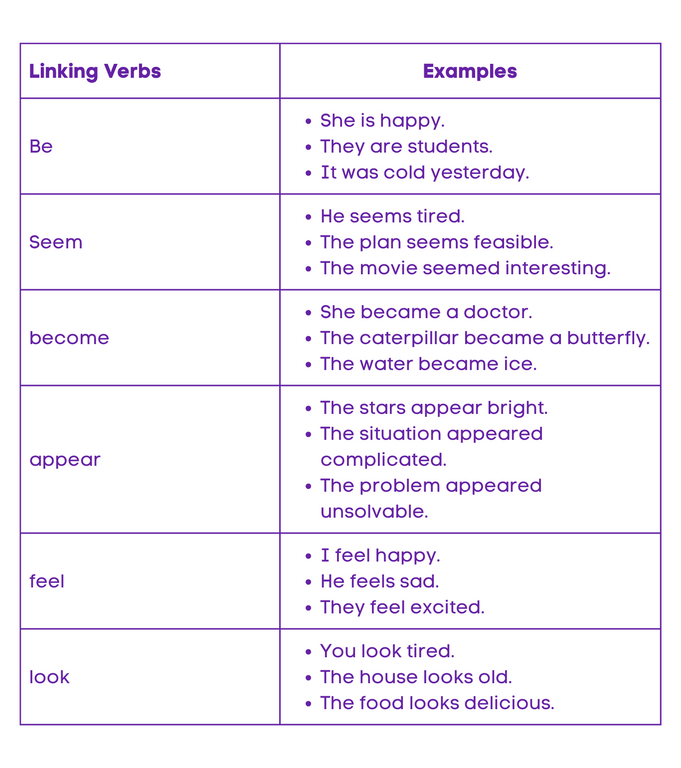Understanding the Role of Linking Verbs in English Grammar
Introduction
Linking Verbs
In the realm of English grammar, linking verbs play a crucial role in connecting the subject of a sentence to a word or phrase that renames or describes the subject. Understanding the function and usage of linking verbs is essential for constructing meaningful and coherent sentences.
Analogy of Definition
What are Linking Verbs?
Linking verbs, also known as copulas, are verbs that do not show action but instead connect the subject of the sentence to a word or phrase that identifies or describes the subject. They serve as a link between the subject and the complement, which can be a predicate nominative or a predicate adjective.
Method
How to Use Linking Verbs
Linking verbs are used to connect the subject of a sentence to a predicate nominative or a predicate adjective. A predicate nominative is a noun or pronoun that follows the linking verb and renames the subject, while a predicate adjective is an adjective that follows the linking verb and describes the subject.
Every sentence consists of two essential parts: a subject and a predicate. The subject, usually a noun, initiates the action of the sentence and typically appears at the sentence’s outset. In a typical sentence with action verbs, the predicate elucidates the action performed by the subject. Take for instance:
“The cat chased the mouse.”
Here, “The cat” serves as the subject, executing the action, while “chased the mouse” forms the predicate. The verb “chased” denotes the action, functioning as an action verb. Additionally, the prepositional phrase “the mouse” elaborates on the action’s target, thus becoming part of the predicate.
However, sentences featuring linking verbs entail distinct predicates, known as subject complements, which don’t delineate an action but instead describe the subject. Subject complements can take two forms:
Predicate Nominative (Predicate Noun): This occurs when words describing the subject consist of nouns or noun phrases.
For example:
“She is an artist.”
In this sentence, “She” is the subject, and “an artist” serves as the predicate nominative. The linking verb “is” links the subject to its description, “an artist.”
Predicate Adjective: This form occurs when words describing the subject are adjectives or adjective phrases.
For example:
“The flowers are beautiful.”
Here, “The flowers” is the subject, and “beautiful” acts as the predicate adjective. The linking verb “are” connects the subject to its descriptor, “beautiful.”
It’s essential to note that subject complements may include phrases as part of the predicate nominatives or predicate adjectives. For instance:
“They seemed exhausted after the long journey.”
In this sentence, the linking verb “seemed” connects the subject “They” to the predicate adjective “exhausted.” Furthermore, the prepositional phrase “after the long journey” provides context, explaining when and why they seemed exhausted, thus becoming part of the predicate adjective.
Identifying Linking Verbs
Let’s consider the sentence “The flowers smell sweet.” In this sentence, the linking verb “smell” connects the subject “flowers” to the predicate adjective “sweet,” which describes the flowers. Another example is “She is a doctor,” where the linking verb “is” connects the subject “She” to the predicate nominative “doctor,” which renames the subject.
Examples

Quiz
Tips and Tricks
1. Recognize Common Linking Verbs
Tip: Memorize common linking verbs such as “be” (is, am, are, was, were), “seem”, “become”, “appear”, “feel”, “look”, “sound”, “smell”, and “taste”.
2.Understand Their Function
Tip: Linking verbs connect the subject of a sentence to a noun, pronoun, or adjective that describes or renames the subject. Unlike action verbs, they do not show action but rather a state of being or condition.
3. Identify Predicates
Tip: Look for verbs in sentences that link the subject to a description rather than showing action. If the verb doesn’t convey an action but rather a state or condition, it’s likely a linking verb.
4. Pay Attention to Context
Tip: Consider the context of the sentence. Linking verbs often appear in sentences describing states, conditions, or appearances rather than actions.
5. Look for Subject Complements
Tip: Linking verbs are often followed by subject complements, which provide information about the subject. Subject complements can be nouns, pronouns, or adjectives.
Real life application
Story: “The Adventures of Detective Grammar”
Detective Grammar was known for his keen eye for detail and his ability to solve language mysteries. In one of his cases, he encountered various situations where linking verbs played a crucial role in unraveling the truth.
Case 1: The Mystery of Identity
Detective Grammar was investigating a case where a suspect claimed to be a renowned author. By analyzing the suspect’s statement, Detective Grammar identified the linking verb “is” that connected the suspect to the predicate nominative “author,” revealing the suspect’s true identity.
Case 2: The Emotion Conundrum
In another case, Detective Grammar was deciphering a cryptic message that seemed to convey conflicting emotions. By recognizing the linking verb “seems” in the message, Detective Grammar was able to understand the true sentiment behind the words and solve the emotional puzzle.
Case 3: The Transformation Challenge
During a challenging investigation, Detective Grammar encountered a situation where a character’s appearance seemed to change dramatically. By identifying the linking verb “becomes” in a witness’s testimony, Detective Grammar uncovered the truth behind the mysterious transformation.
FAQ's
Like? Share it with your friends






